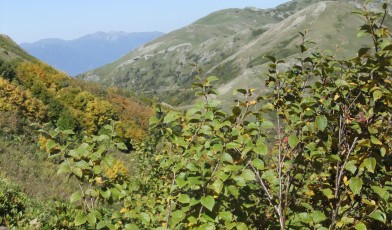The Transcaucasian birch is one of a group of unique and rare trees and shrubs in the Caucasus Mountains. These relict species were once widespread across the Northern Hemisphere but are now confined to the Caucasus Mountains where it has been protected from the great ice ages. This ancient species has recently been assessed as Near Threatened , due to a decreasing population caused by overgrazing and logging.
This multi-stemmed shrub is capable of growing to 5m and is very attractive. It has metallic silvery-yellow bark, bright yellow autumnal foliage and large upright fruiting catkins. It is found growing in sub-alpine mixed forests and open hillsides at elevations of 600-2400m along with other rarities such as Epigaea gaultherioides, Quercus pontica and Rhododendron ungernii.
Numerous qualities of the Transcaucasian birch make it susceptible to threats. The shrub has a limited range due to its niche habitat requirements; it prefers limestone based soils, is slow growing, and is shade intolerant. This means the shrub is constrained to growing above the tree-line where there is the correct soil, less competition from fast growing species and less likelihood of being shaded. Additionally the seed of this birch lack wings so the seeds cannot be dispersed very far.
A major threat to this species is over-grazing from both wild and domestic animals such as goats and cows. The slow growth of this shrub makes it extremely vulnerable to over-grazing and the damage from grazing animals can disrupt the plant’s ability to flower, produce and disperse seeds. This species is also threatened by large scale logging which occurs across its range. Already in Georgia both these threats have led to fragile and unstable populations and the shrub is considered rare.
Poor economy and little control over forestry and agricultural practices across the Caucasus Mountains as well as the shrub’s limited range, poor seed dispersal and slow growth means that the loss of trees from uncontrolled clearing and over grazing has the potential to seriously damage the already declining population of this species.
Did you know?
The bristlecone pine may be the world’s oldest known living organism. One tree found in California’s White Mountains is 5,062 years old.
